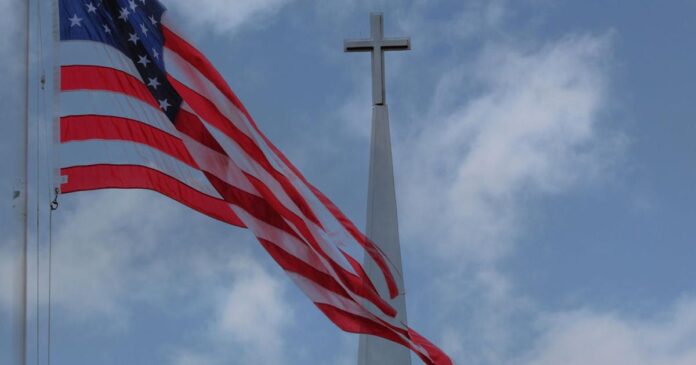On the surface, it seems like 2022 was a year of conservative triumph in the courts and in schools, as U.S. Supreme Court decisions about religion and education joined other precedent-smashing opinions about abortion rights and gun control. The school decisions seemed to fulfill long-held conservative dreams about pushing prayer back into public classrooms and diverting tax funding to explicitly religious schools.
But looking at the language of these rulings — especially Justice Neil M. Gorsuch’s majority decision in Kennedy v. Bremerton School District — points to another conclusion. These rulings unwittingly opened the door to a secular vision for America’s public schools by emphasizing the need to look at history, especially the original intention of the founders, when making decisions on the role of religion in public schools.
People are also reading…
In Kennedy, a football coach insisted on his right to lead students in prayer after a football game. On its face, the case seemed open-and-shut. The Supreme Court had ruled in 2000, for instance, that students could not lead prayers at public school football games. It seemed to follow that teachers and coaches could not as well.
To evade that precedent, Gorsuch turned to a 1963 decision, Abington School District v. Schempp, but flipped it on its head. “‘[T]he line,’” Gorsuch wrote, quoting Justice William Brennan’s much-quoted concurring opinion in Schempp, “that courts and governments ‘must draw between the permissible and the impermissible’” has to “accor[d ] with history and faithfully reflec[t] the understanding of the Founding Fathers.”
With this, Gorsuch hoped to cram prayer back into public schools. He imagined that in the time of the Founding Fathers, religion — and specifically an evangelical Protestant kind of Christian religion — was welcomed into schools and government institutions.
Despite Gorsuch’s efforts, however, the real history is much more complicated, and the founders were decidedly mixed on the proper role of religion in public schools.
For one thing, it is utterly anachronistic to talk about “public schools” in the 1780s and 1790s. They simply did not exist in a recognizable form. But the founding generation did have a variety of different visions for the future of public schools and how they should function.
Some founders, such as Thomas Jefferson, explicitly and intentionally barred religion from the public schools they had imagined. In 1779, Jefferson offered his vision of what a public school system might look like. He listed the subjects to be taught — “the Latin and Greek languages, English grammar, geography, and the higher part of numerical arithmetick” — conspicuously leaving out any instruction in religious ideas. The omission was intentional. “Instead of putting the Bible and Testament” in the hands of schoolchildren, Jefferson wrote in 1781, children should instead learn “the most useful facts from Grecian, Roman, European and American History.”
Jefferson was far from alone. Noah Webster, the famous dictionary writer and textbook author, envisioned public schools as explicitly civic, not religious institutions. In his early textbooks, Webster even went through old classics and removed references to God and Christianity. For instance, in an early reader, Webster took out the famous Puritan opening line from the New England Primer: “A. In Adam’s Fall, We sinned all.” Webster replaced it with a more cheerful, American, secular line: “A. Was an Apple-pie made by the cook.”
Certainly, some prominent founders assumed that truly American public schools must inculcate the Christian religion. When Philadelphia’s Benjamin Rush envisioned a new system of public schools, he sketched a definition of public education that some of today’s conservatives might like. As Rush explained, the “only foundation for a useful education in a republic is to be laid in Religion.” And the correct American religion, Rush made clear, “is that of the New Testament.”
Yet even Rush made some stipulations to ensure that the government’s needs would take definite priority in all questions of education. Children, Rush specified, must be seen as “public property,” with their careers guided first by government need and only second by their own private desires. They must be taught to “forsake and even forget” their family if the state demanded it.
Moreover, while the founders had no single opinion on the role of religion in school, they tended to agree on two broad issues. First, in language that has been lost and distorted by today’s conservatives, Americans in the late 1700s and early 1800s usually agreed that any religion in public schools must be aggressively “nonsectarian.” By that, they meant that public schools must exclude any religious idea that was considered controversial at the time, or any idea that was specific only to one religious group and not widely shared as a generic moral truth.
Did Christians need an adult baptism, as many Baptists insisted? Were Christians really devoid of free will, as some Congregationalists still preached? Was Jesus merely a sublime teacher of morals, as Deists believed? These questions might seem finicky now, but in the late 1700s they could spark riots and bloodshed. The founders did not agree on much, but they agreed that public schools must fervently avoid any whiff of religious controversy.
And perhaps more important, the Founding Fathers — as well as the founding mothers and their children — agreed that any truly public school could not be run by a church for religious reasons. They believed that a public school had to be something that promoted purely public purposes. They thought a public school must teach citizens how to protect their republic, not how to save their souls.
The Supreme Court decisions in 2022 contradict those founding principles. They cram controversial religious ideas into public schools and funnel public funding to church schools. Instead of answering difficult questions about the proper role of religion in public schools, Gorsuch’s opinion only raises a host of new, unsolvable dilemmas.
If today’s lines are to be drawn based on the dreams of the founding generation, does that mean a broad support for Rush’s Christian schools, wherein families lose their right to control their children’s education? Or does it mean Jefferson’s secular ones, in which the Bible takes a back seat to every other subject?
The founders offered no clear guidance or consensus on the matter, creating a real problem for conservatives today. If the courts try to follow Gorsuch’s opinion and look to the Founding Fathers for answers, they will be sure to find perspectives advocating for more secular schools. They will find opposition to sending tax dollars to church schools. The supposed triumph of conservative ideas will instead turn into a rejection of their controversial edicts.
From the Archives: Mayo Island through the years
Mayo Bridge and Island

Aerial photos Richmond area, including Main Street Station, Interstate 95, Shockoe Bottom, Downtown, Mayo Island, Church hill

Birds fly over Mayo Island in the James River on February 13th, 2008

Mayo Island in the James River, from the Flood Wall on the south bank of the river.

In July 1940, a Richmond Colts batter headed to first base while a teammate scored in a victory over the Norfolk Tars in a Piedmont League game at Tate Field, which was on Mayo Island in Richmond.

4-27-1937: During the 1937 flood, the old ball park on Mayo Island looked like a lake.

This January 1931 image shows Tate Field, located on Mayo Island in the James River and used for several Richmond baseball teams from 1890 to 1941. The ballpark, named for 1880s local player Edward “Pop” Tate, had recurring problems with flooding, and a fire caused significant damage in 1941.

10-18-1942 (cutline): Flood waters from James River pour over old Mayo Island Baseball Park just off of Fourteenth Street Bridge. Picture taken from atop Richmond Boast Club building shows bleachers isolated by water.

John Jay Schwartz, on the 14th Street Bridge, is a Richmond broker who has Mayo Island as one of his listings. Part of Mayo Island is the wooded area behind him. Aug. 14, 2014.

A helicopter lowers a briefcase on Mayo Island Saturday, July 12, 1997, during the celebrations prior to the start of the Peace Frog Race. The briefcase contained destination check points for the race.

This historical photo of the baseball diamond that existed on Mayo Island in Richmond, VA, was made by Dementi Studio. (No date information for this photo was given.)

Sarah Dingle and Matt Dingle compete in the 2X14DR class of the Downriver Competition in the 1998 Open Canoe Downriver and Slalom National Championships Friday, June 19, 1998. They paddle through waterpipe rapid nearing Mayo Island.

Jen Watkins and Rob Scharges compete in the 2X14DR class of the Downriver Competition in the 1998 Open Canoe Downriver and Slalom National Championships Friday, June 19, 1998. They paddle through waterpipe rapid nearing Mayo Island.

Audience members sing along with songs at Carbon Leaf’s Endless Summer Luau and Campout on Mayo Island on 7/20/02. (Carbon Leaf on stage)

Backstage view of Carbon Leaf at Carbon Leaf’s Endless Summer Luau and Campout on Mayo Island on 7/20/02.

Donna Shell, with the National Environmental Trust, wore her global hat created by Ignatius Hats Saturday, April 19, 1998, for the Earth Day concert at Mayo Island. She was getting people to sign postcards to their senators to combat global warming.

Lisa Winnagle shakes a rattle to the beat of Baaba Seth’ music Saturday, April 19, 1998, at the Earth Day concert at Mayo Island.

Michelle Hand and Chris Hunter, both of Augusta, dance to the beat of Baaba Seth’ music Saturday, April 19, 1998, at the Earth Day concert at Mayo Island.

Large crowd gathers on Mayo Island to celebrate Earth Day.

Richmond fire officials have not determined the cause of the blaze at the paper warehouse, 508 S. 14th St. on Mayo’s Island. April 3, 1989.

Ahnna Rinaldi, 10 of Sandston, holds at red rat snake (also known as a corn snake) during the Fish Festival now incorporated into the Earth Day festivities on Mayo Island on April 19, 2008. In background is naturalist Ralph White.

Jayden Tatum, 4 of Baltimore, gets some help from his dad while learning to fish at the James River during the Fish Festival now incorporated into the Earth Day festivities on Mayo Island on April 19, 2008.

Watched by Orvis’ Dale Huggins, Quraan Randolph, 7 of Baltimore learns to fly cast during the Fish Festival now incorporated into the Earth Day festivities on Mayo Island on April 19, 2008.

James “Tony” Borst has lived on the small islands near the Mayo bridge and downtown Richmond on and off for the past 20 years. Here, Borst is seen on Devil’s Kitchen Island with a view of downtown Richmond in the background.

Joseph “J.D.” Osborne has lived on the islands in the James River near the Mayo bridge and downtown Richmond on and off for over 10 years. Here, Osborne, originally from Mecklenburg, Va., relaxes near his campsite on May 29, 2009.

With fly rod in hand, Dale Huggins discusses shad fishing strategy on the James River near Mayo Island. The Hickory shad, and to a lesser extent the American shad, have begun their annual run upstream to spawn.

Mayo Island

Young people listen to the music of Everlast at Mayo Island in Richmond Aug.14, 1999

Michael Tobin , men’ s XTERRA winner crosses the finish line at Mayo’s Island . July 18,1999
Adam Laats is professor of education at Binghamton University (SUNY) and author of “Fundamentalist U.” and “The Other School Reformers.” Follow him on Twitter @AdamLaats.
Credit: Source link































